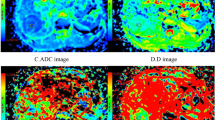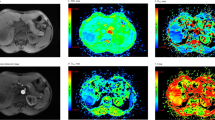Abstract
Objectives
To investigate the effectiveness of qualitative diffusion-weighted imaging (DWI), subtraction of unenhanced from arterial phase images, and hepatobiliary phase (HBP) images in estimating the histopathological grade of hepatocellular carcinoma (HCC).
Methods
We retrospectively reviewed gadoxetic acid–enhanced magnetic resonance images of 175 patients with 201 surgically resected HCCs. The signal intensity and its relationship with histopathological grade were assessed for each sequence and a combination of sequences.
Results
There was a tendency towards higher grades in tumours showing restricted diffusion on DWI (P < 0.001) or arterial enhancement on subtraction imaging (P <0.001), but not hepatocyte-defect on HBP images (P = 0.33). When lesions were divided into three groups based on combined findings on DWI and subtraction imaging, a linear trend was observed between group and grade (P < 0.001). The positive predictive value (PPV) of the combination of no restricted diffusion and no arterial enhancement in predicting well-differentiated HCC was 100%, higher than the PPV of individual findings on DWI (74%) or subtraction imaging (81%).
Conclusions
DWI and subtraction imaging are helpful for predicting the histopathological grade of HCC, especially when the two sequences are considered together.
Key Points
• Predicting the histopathological grade of hepatocellular carcinoma (HCC) preoperatively is important.
• Diffusion-weighted imaging (DWI) and subtraction imaging are recently developed MR techniques.
• Retrospective study showed DWI and subtraction imaging helps predict HCC grades.
• Management of patients with HCC becomes more appropriate.



Similar content being viewed by others
References
Jonas S, Bechstein WO, Steinmuller T et al (2001) Vascular invasion and histopathologic grading determine outcome after liver transplantation for hepatocellular carcinoma in cirrhosis. Hepatology 33:1080–1086
Ker CG, Chen HY, Chen KS et al (2003) Clinical significance of cell differentiation in hepatocellular carcinoma. Hepatogastroenterology 50:475–479
Ariizumi S, Takasaki K, Yamamoto M, Ohtsubo T, Katsuragawa H, Katagiri S (2004) Histopathologic differentiation of the main nodule determines outcome after hepatic resection for synchronous multicentric hepatocellular carcinomas. Hepatogastroenterology 51:500–504
Prez-Saborido B, de los Galanes SJ, Menu-Daz JC et al (2007) Tumor recurrence after liver transplantation for hepatocellular carcinoma: recurrence pathway and prognostic factors. Transplant Proc 39:2304–2307
Haratake J, Takeda S, Kasai T, Nakano S, Tokui N (1993) Predictable factors for estimating prognosis of patients after resection of hepatocellular carcinoma. Cancer 72:1178–1183
Okusaka T, Okada S, Ueno H et al (2002) Satellite lesions in patients with small hepatocellular carcinoma with reference to clinicopathologic features. Cancer 95:1931–1937
Oishi K, Itamoto T, Amano H et al (2007) Clinicopathologic features of poorly differentiated hepatocellular carcinoma. J Surg Oncol 95:311–316
Kogita S, Imai Y, Okada M et al Gd-EOB-DTPA-enhanced magnetic resonance images of hepatocellular carcinoma: correlation with histological grading and portal blood flow. Eur Radiol 20:2405-2413
Nishie A, Tajima T, Asayama Y et al (2010) Diagnostic performance of apparent diffusion coefficient for predicting histological grade of hepatocellular carcinoma. Eur J Radiol 80:e29–e33
Nasu K, Kuroki Y, Tsukamoto T, Nakajima H, Mori K, Minami M (2009) Diffusion-weighted imaging of surgically resected hepatocellular carcinoma: imaging characteristics and relationship among signal intensity, apparent diffusion coefficient, and histopathologic grade. AJR Am J Roentgenol 193:438–444
Heo SH, Jeong YY, Shin SS et al (2010) Apparent diffusion coefficient value of diffusion-weighted imaging for hepatocellular carcinoma: correlation with the histologic differentiation and the expression of vascular endothelial growth factor. Korean J Radiol 11:295–303
Edge SB, Byrd DR, Compton CC, Fritz AG, Greene FL, Trotti A (2009) AJCC cancer staging manual, 7th edn. Springer, New York
Mazzaferro V, Regalia E, Doci R et al (1996) Liver transplantation for the treatment of small hepatocellular carcinomas in patients with cirrhosis. N Engl J Med 334:693–699
Landis JR, Koch GG (1977) The measurement of observer agreement for categorical data. Biometrics 33:159–174
Muhi A, Ichikawa T, Motosugi U et al (2009) High-b-value diffusion-weighted MR imaging of hepatocellular lesions: estimation of grade of malignancy of hepatocellular carcinoma. J Magn Reson Imaging 30:1005–1011
Yu JS, Kim YH, Rofsky NM (2005) Dynamic subtraction magnetic resonance imaging of cirrhotic liver: assessment of high signal intensity lesions on nonenhanced T1-weighted images. J Comput Assist Tomogr 29:51–58
Secil M, Obuz F, Altay C et al (2008) The role of dynamic subtraction MRI in detection of hepatocellular carcinoma. Diagn Interv Radiol 14:200–204
Asayama Y, Yoshimitsu K, Nishihara Y et al (2008) Arterial blood supply of hepatocellular carcinoma and histologic grading: radiologic-pathologic correlation. AJR Am J Roentgenol 190:W28–W34
Narita M, Hatano E, Arizono S et al (2009) Expression of OATP1B3 determines uptake of Gd-EOB-DTPA in hepatocellular carcinoma. J Gastroenterol 44:793–798
Author information
Authors and Affiliations
Corresponding author
Rights and permissions
About this article
Cite this article
An, C., Park, MS., Jeon, HM. et al. Prediction of the histopathological grade of hepatocellular carcinoma using qualitative diffusion-weighted, dynamic, and hepatobiliary phase MRI. Eur Radiol 22, 1701–1708 (2012). https://doi.org/10.1007/s00330-012-2421-6
Received:
Revised:
Accepted:
Published:
Issue Date:
DOI: https://doi.org/10.1007/s00330-012-2421-6




